In today's hyper-competitive online marketplace, having a robust presence on Amazon is crucial for businesses aiming to thrive. With millions of products vying for attention, standing out from the crowd requires strategic advertising efforts. This is where Amazon advertising services come into play. Let's delve into the top benefits of enlisting the expertise of an Amazon advertising agency in the USA.
Expertise in Amazon's Advertising Platform: Navigating Amazon's advertising platform can be complex, with various ad types, targeting options, and metrics to consider. Amazon advertising agencies specialize in leveraging these tools to maximize your ROI and drive sales.
Strategic Campaign Management: Crafting and managing effective advertising campaigns requires careful planning and execution. Amazon advertising agencies develop tailored strategies based on thorough market research and data analysis to ensure your ads reach the right audience at the right time.
Optimized Product Visibility: With millions of products on Amazon, getting your offerings noticed amidst the competition can be challenging. Amazon advertising agencies employ advanced optimization techniques to enhance your product visibility, driving traffic and conversions.
Budget Optimization: Maximizing the impact of your advertising budget is crucial for achieving sustainable growth. Amazon advertising agencies utilize advanced algorithms and techniques to optimize your ad spend, ensuring every dollar delivers tangible results.
Continuous Performance Monitoring: Monitoring the performance of your advertising campaigns in real-time is essential for making data-driven decisions and optimizing results. Amazon advertising agencies provide comprehensive performance reports and analytics, allowing you to track progress and make adjustments as needed.
Access to Beta Features and Insights: Staying ahead of the curve on Amazon requires access to the latest features and insights. Amazon advertising agencies often have access to beta features and insider knowledge, giving your campaigns a competitive edge.
Focus on Core Business Activities: Managing advertising campaigns can be time-consuming, diverting valuable resources away from core business activities. By outsourcing your Amazon advertising to a specialized agency, you can focus on growing your business while experts handle your advertising needs.
Adaptability to Market Changes: The e-commerce landscape is constantly evolving, with new trends and technologies emerging regularly. Amazon advertising agencies stay abreast of these changes and adapt their strategies accordingly, ensuring your campaigns remain effective in the ever-changing marketplace.
In conclusion, partnering with an Amazon advertising agency in the USA offers a myriad of benefits, from expert campaign management to optimized budget allocation and access to cutting-edge insights. By harnessing the expertise of seasoned professionals, businesses can unlock the full potential of their Amazon advertising efforts and achieve sustainable growth in the highly competitive e-commerce arena.
Read More: Top Benefits of Hiring an Amazon Advertising Agency in the USA






